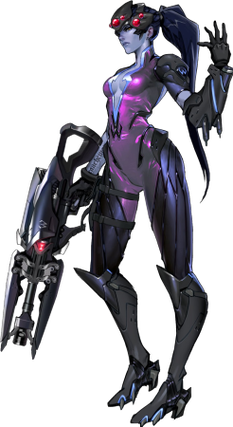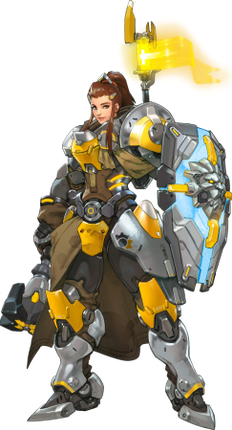
John Francis "Jack" Morrison, known by his code name Soldier: 76, is a character in Blizzard Entertainment's Overwatch franchise, first appearing in Overwatch and its 2022 sequel Overwatch 2, both of which are team-based multiplayer first-person shooters. In the games, Jack is an American soldier-turned-vigilante and a founding member of the game's titular organization. Designed to appeal to newcomer players, Soldier: 76 wears a visor on top of his facemask and carries an experimental rifle. Soldier: 76 originated as a comic book concept conceived by former Blizzard employee Chris Metzen in the early 2000s, and is later modified and repurposed for inclusion in Overwatch. A short story published by Blizzard in January 2019 details his past relationship with his same-sex domestic partner.

D.Va is a character developed by Blizzard Entertainment for their Overwatch franchise. She was introduced at launch in their 2016 first-person hero shooter video game Overwatch and returned in its 2022 sequel, Overwatch 2. She features in the franchise's related animations and literary media. Outside of Overwatch, D.Va also appears as a playable character in the crossover multiplayer online battle arena (MOBA) game Heroes of the Storm and as a gameplay announcer in StarCraft II: Legacy of the Void. In English-language media, D.Va is voiced by Charlet Chung.

Overwatch was a 2016 multiplayer first-person shooter video game by Blizzard Entertainment. The game was first released for PlayStation 4, Windows, and Xbox One in May 2016 and Nintendo Switch in October 2019, with cross-platform play supported across all platforms. Described as a "hero shooter", Overwatch assigned players into two teams of six, with each player selecting from a large roster of characters, known as "heroes", with unique abilities. Teams worked to complete map-specific objectives within a limited period of time. Blizzard added new characters, maps, and game modes post-release, all free of charge, with the only additional cost to players being optional loot boxes to purchase cosmetic items.
Tracer is a character who appears in Overwatch, a franchise centered around first-person hero shooter video games developed by Blizzard Entertainment. Tracer was first seen in the 2014 Overwatch Cinematic Trailer short. She was introduced as a playable character in an April 2016 update for the crossover multiplayer online battle arena game Heroes of the Storm, nearly a month prior to the release of the first Overwatch game. She appeared again in Overwatch 2, a 2022 sequel to the original game.
The Overwatch franchise, a series of first-person shooter games developed by Blizzard Entertainment, consists of 42 playable characters across both games. The original 2016 game, Overwatch, featured 32 playable characters known as heroes and a number of supporting characters as part of the game's narrative, which is told through animated media and digital comics outside of the game. Its sequel, Overwatch 2, was released in October 2022 and replaced Overwatch. The sequel builds upon the same hero roster and added more characters, currently consisting of 42 heroes. However, as Overwatch 2 had been developed to be a faster game with five-versus-five teams rather than six-versus-six, several of the characters had tweaks or major rebuilds within Overwatch 2, as well as different character designs.

Pharah, real name Fareeha Amari, is a character who first appears in the 2016 video game Overwatch, a Blizzard Entertainment-developed first-person shooter. Voiced by Jen Cohn, she is an Egyptian woman trying to follow in her mother's footsteps, enlisting in a military unit and helping to defend her local community, going by the call sign "Pharah". She later joins the restored peace-keeping force Overwatch alongside her mother and childhood friend. In a 2023 short story by Blizzard, the character was revealed to be a lesbian.

Widowmaker is a character who first appeared in the 2016 video game Overwatch, a Blizzard Entertainment–developed first-person shooter. She first appeared at the launch of the 2016 first-person hero shooter game Overwatch, and subsequently in its 2022 sequel, Overwatch 2. Conceived by Jeff Kaplan in the early development phases of the game, her design was fleshed out by Arnold Tsang and other Blizzard artists. Voiced by Chloé Hollings, 'Widowmaker' is the alias of Amélie Lacroix, a French ballerina-turned-sleeper agent for the terrorist organization Talon, who after killing her husband becomes a high-profile sniper assassin. Since the game's release she has appeared in various spinoff media related to the franchise, including comics and merchandise.

Zarya, full name Aleksandra Zaryanova, is an Overwatch character who first appears in the 2016 video game of the same name, a Blizzard Entertainment–developed first-person shooter. Voiced by Dolya Gavanski, Zarya is a Siberian champion weightlifter who enlists in a local defense force after her home comes under attack from robotic forces, later joining the restored peacekeeping force Overwatch. Conceived due to Geoff Goodman's desire to include a heavy weapon wielding character into the game, she was designed by Arnold Tsang after watching a weightlifting competition, feeling the concept would make for a strong character. Since her introduction, she has appeared in various spinoff media related to the franchise, including comics and merchandise, and later in another Blizzard developed title, Heroes of the Storm.

Blizzard Entertainment's 2016 video game Overwatch inspired a notable amount of fan-made pornography. The game's distinct and colorful character designs drew the attention of many online content creators, resulting in sexually explicit fanart. Character models were ripped from the beta versions of the game and subsequently spread, edited, and animated on the Internet.

Sombra, real name Olivia Colomar is a fictional character in the Overwatch universe, a 2016 video game developed by Blizzard Entertainment. In the game's narrative, she is an exceptional black bag operation hacker from Mexico that had joined Talon, a criminal organization aligned against Overwatch. In game, Sombra has stealth-based abilities to move around the battlefield, and is able to hack any opposing character to briefly prevent them from using their special abilities.
Overwatch and Overwatch 2 are online team-based first-person shooters developed by Blizzard Entertainment, and released worldwide in May 2016 and October 2022, respectively. Players select from one of over 30 heroes, broadly classified into the three roles of Tank, Damage, and Support, and work with their team to attack or defend map objectives. Each hero has a unique set of weapons, abilities, and skills, which players use to coordinate with their team to overpower the other. Overwatch supports both casual and ranked matchmaking, as well as a rotating set of arcade modes, and the game has since become a popular esport, featuring the Overwatch League that started in 2018. The game has been both a critical and financial success for Blizzard, exceeding over 30 million players and obtaining over US$1 billion in revenue within its first year.

Hanzo Shimada is a playable character appearing in the 2016 video game Overwatch, a first-person shooter video game developed by Blizzard Entertainment. Outside of Overwatch, Hanzo also appears in related media, which includes animated shorts and webcomics, as well as a playable character in the crossover multiplayer online game Heroes of the Storm. He appeared again in Overwatch 2, a 2022 sequel to the original game.

Dr. Mei-Ling Zhou, commonly simply referred to as Mei, is a character who first appears in the 2016 video game Overwatch, a Blizzard Entertainment–developed first-person shooter. Originally conceived as a Canadian bounty hunter named "Frostbite" who encased her targets in ice, she was changed due to the developers feeling a light tone was necessary for the character, and redesigned her as a cute, Chinese scientist. Voiced by Yu "Elise" Zhang, Mei is stationed in Antarctica as part of the efforts of "Overwatch", a global peace-keeping force, to monitor climate change. After being revived from cryopreservation, she helps the reformed group combat a global threat, utilizing a pistol that can either generate ice beams or generate ice constructs, accompanied by her sentient drone Snowball. Since her introduction, she has appeared in various spinoff media related to the franchise, including comics and merchandise, and later in another Blizzard developed title, Heroes of the Storm.

Doomfist, full name Akande Ogundimu, is a character who first appears in the 2016 video game Overwatch, a Blizzard Entertainment–developed first-person shooter. His design is based on a powerful, cybernetic gauntlet. As an offensive, brawler-style character, he uses close-range attacks: a charged punch and slam. Doomfist was released in late July 2017 as the title's 25th hero of the franchise, and the fourth introduced after the game's launch.

Moira O'Deorain is a character from the 2016 video game Overwatch, a Blizzard Entertainment–developed first-person shooter. First appearing in a 2017 tie-in comic, she was later added as a playable character in an update for the game, and returned for its sequel. Voiced by Genevieve O'Reilly, Moira serves as a healer who can refill her resources by damaging enemies with her main attack. Within the Overwatch story, she is an Irish geneticist who refuses to let any ethical constraints interfere with scientific advancement, and works with the terrorist group Talon to this end while posing as a member of the scientific community. Since the game's release she has appeared in various spinoff media related to the franchise, including comics and merchandise.
Overwatch is a team-based first-person shooter developed by Blizzard Entertainment and released for Microsoft Windows, PlayStation 4, and Xbox One in May 2016. The game, while having several different play modes, generally features two teams of six players each, selecting pre-made heroes from the game's roster, to either attack or defend various objective points on the game's maps. The game supports casual game modes as well as ranked competitive play. Since release, Overwatch has been both critically and financially successful, with a player base of 35 million players as of October 2017.

Brigitte Lindholm is a fictional player character who appears in the 2016 video game Overwatch—a first-person shooter developed by Blizzard Entertainment—and related animations and literary media. Although Overwatch was released in 2016, Brigitte was introduced as a playable support character in a March 2018 update for the game. Prior to her video game debut, she first appeared in Dragon Slayer, an issue of the Overwatch digital comic series.
Overwatch and Overwatch 2 are team-based first-person shooter games developed by Blizzard Entertainment. Overwatch was released in May 2016 for several platforms. The game features a number of gameplay modes that support casual play, ranked play, and competitive modes used for professional esports events, such as the Overwatch League. Overwatch 2 was released in October 2022 with the same player versus player (PvP) modes, and will later include new player versus environment (PvE) co-operative multiplayer modes.

Kiriko Kamori is a fictional character in the Overwatch media franchise. Her first appearance was in Overwatch 2, a 2022 first-person shooter developed by Blizzard Entertainment. Kiriko's character design and gameplay mechanics draw from the imagery found in Japanese folklore and Shinto folk religion. In the game's lore, her mother trained her to be a ninja, while her grandmother taught her about spirituality and her ancestry. Combining her two matriarchal influences, Kiriko carries the power of a kitsune, which she uses to protect her native Kanezaka, a fictional Japanese city.

Overwatch is a multimedia franchise centered on a series of multiplayer first-person shooter (FPS) video games developed by Blizzard Entertainment. Overwatch was released in 2016 with a successor, Overwatch 2, released in 2022. Both games feature hero-based combat between two teams of players vying over various objectives, along with other traditional gameplay modes.

















